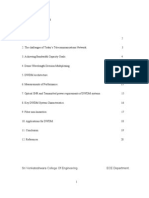DWDM Network
Uploaded by
sin4416DWDM Network
Uploaded by
sin4416DWDM Performance and Conformance Testing
Primer
A Typical Optical Network
Signals in the core ring pass from one DWDM link to the next core ring.
To understand optical networks in greater depth, examine the structure
Within each DWDM link, specific SONET or SDH colors or channels can
of the typical optical network in Figure 1. The network elements shown
be routed to metro or access network tributaries, or to other core rings.
on this topology map are all representative. Actual networks may contain
In the past, DWDM elements were not used in the network SDH/SONET
all or only some of these network elements, and certain other common
electro-optical add/drop multiplexers (ADMs) were used to move
network elements are not represented here for simplicitys sake.
tributaries off of or onto the core. Today, the tributary channels can be
Two key structures comprise the network:
routed to a DWDM link or an ADM. The lightwave-based channel is
converted into an electrical signal, then back into component SONET,
The core network, made up of a high-speed IP backbone or telephony
SDH, DSn (e.g., T ) or PDH (e.g., E ) signals. These signals are then
1
switching network handling voice traffic (typically at 2.5 to 10 Gbit/s)
A local or metropolitan network splitting off from the core through a WDM
element (typically at 155 to 622 Mbit/s)
routed to tributaries at different locations. Within the ADM, the signal
is decomposed further into different channels at lower, standard ANSI
or ETSI data rates such as T , E , DS , E , etc.
1
In this illustration, the high-speed core network is configured as interconnected rings that make up a complete telecommunications network.
Core Network
DWD
DWD
DWD
DWD
ADM
ADM
Metro/Access Network
MUX
DCS
MUX
MUX
DCS
MUX
Figure 1. A simplified optical network with a ring architecture.
www.tektronix.com/optical
DWDM Performance and Conformance Testing
Primer
Structure of a Typical DWDM Link
signal is broken into its individual channels and parsed out to each
To investigate the complexity of a optical network more closely, lets
receiving element.
examine the structure of a typical point-to-point DWDM link deployed
Two general categories of opticals networks are available: Open (stand-
in todays networks (Figure 2).
alone) systems and integrated (terminal) systems. Open systems are
On the left are the various channels Tx1, Tx2, etc. Each DWDM link
characterized by their ability to accept and transport a variety of incoming
may contain as many as 128 transmitters per channel (with more possi-
signals with a range of formats and characteristics. This is achieved by
ble in the future). The signal from each channel is directed into the
providing signal conversion and wavelength adaptation using, for example,
wavelength multiplexer, to be combined and sent onto the optical path,
a transponder or a remodulator function. In this way, non-compliant sig-
through the optical amplifier, and then on to a demultiplexer. There, the
nals can be adapted and transported by the WDM layer (see Figure 3).
Rx1
Tx1
Tx2
O/E/O
1
Tx3
MUX
O/E/O
n
MUX
DEMUX
OA
Rx2
Rx3
MUX
Figure 2. Overview of a DWDM link.
SDH,
SONET,
ATM,
IP,
other
Optical Supervisory Channel (OSC)
O/E/O
1
G.692 i/f
MUX
OA
O/E/O
n
G.957 i/f
sync
STM-16
MUX
WDM System
(Optical Transport Network)
SDH Core Network
DEMUX
STM-16
optical
n
STM-16
DEMUX
sync
SDH Access Network
(plus SDH tribs, PDH legacy)
STM-1/-1e, 140/34/2 Mbit/s
Figure 3. Generic open WDM system architecture.
4 www.tektronix.com/optical
STM-1/-1e, 140/34/2 Mbit/s
DWDM Performance and Conformance Testing
Primer
Integrated systems are more closely integrated within a parent
In an integrated system, the manufacturer can optimize its own
SONET/SDH system. The SONET/SDH system transmitters themselves
transmitters and, thus, doesnt have to use the intermediate step of
provide the required signal format (i.e., colored light ready for wave-
wavelength shifting.
length multiplexing). (See Figure 4.)
Open WDM systems are generally seen as more flexible able to
Network operators will typically select the architecture suitable for their
transport legacy PDH as well as SDH and other signals at a variety of
purposes by considering their particular economics, installed equipment
bit-rates and optical power levels. On the other hand, there is a risk
base, desired network evolution, and services to be offered. Depending
of increased cost due to the additional equipment and management
upon whether the system being implemented will be open or integrated,
functionality.
different optical-signal treatments will be necessary.
Integrated WDM systems are sometimes positioned as the more suitable
In an open system, equipment providers want their DWDM links to work
solution for the longer term. Client signals can be directly adapted to
with any manufacturers SONET/SDH network. They use open-system
the WDM/physical layer whether the client terminal equipment is an
transponders or wavelength adapters that handle wavelength shifting
SDH admux or an IP router.
or adaptation to given channels on the ITU-T grid (see Appendix C).
Regardless of the optical network architecture employed, rigorous
Taking the channel through the O/E/O conversion allows it to be shifted
testing is required for accurate characterization of components and
to a specific channel within this grid.
conformance with standards.
SDH,
SONET,
ATM,
IP,
other
1
G.692 i/f
Optical Supervisory Channel (OSC)
MUX
OA
sync
STM-16
MUX
DEMUX
STM-16
optical
n
WDM System
(Optical Transport Network)
SDH Core Network
STM-16
DEMUX
sync
SDH Access Network
(plus SDH tribs, PDH legacy)
STM-1/-1e, 140/34/2 Mbit/s
STM-1/-1e, 140/34/2 Mbit/s
Figure 4. Generic integrated WDM system architecture.
www.tektronix.com/optical
You might also like
- Software Engineering - PPT - Unit 1 - Class 1No ratings yetSoftware Engineering - PPT - Unit 1 - Class 111 pages
- Radio Network Planning and Optimisation for UMTSFrom EverandRadio Network Planning and Optimisation for UMTSJaana Laiho4.5/5 (2)
- WDM Networking Technologies: 2.1 Executive Summary of Chapter 2No ratings yetWDM Networking Technologies: 2.1 Executive Summary of Chapter 222 pages
- Understanding Itu G709 Standard For Optical Networks100% (1)Understanding Itu G709 Standard For Optical Networks60 pages
- OTN Optical Layer Protection OP Protection 36PNo ratings yetOTN Optical Layer Protection OP Protection 36P36 pages
- Infinera-Tunable Colorless Network Nodes-MorkelNo ratings yetInfinera-Tunable Colorless Network Nodes-Morkel7 pages
- Script On Optical Network Communication BasicsNo ratings yetScript On Optical Network Communication Basics16 pages
- P-0 OTN Introduction: Confidential Information of Huawei. No Spreading Without Permission100% (1)P-0 OTN Introduction: Confidential Information of Huawei. No Spreading Without Permission70 pages
- OPTera Metro Dense Wave Division Multiplexing Optical NetworkingNo ratings yetOPTera Metro Dense Wave Division Multiplexing Optical Networking10 pages
- Selection of Different ITU-T G.652-FinalNo ratings yetSelection of Different ITU-T G.652-Final8 pages
- Apollo 9504D: Stackable 1.6T DCI/DWDM Transmission PlatformNo ratings yetApollo 9504D: Stackable 1.6T DCI/DWDM Transmission Platform2 pages
- Maximizing Reach-Capacity in Optical Networks With WaveLogic 5 Extreme DSP Innovations WP100% (1)Maximizing Reach-Capacity in Optical Networks With WaveLogic 5 Extreme DSP Innovations WP5 pages
- Long Haul DWDM SFP: Dense Wavelength Division Multiplexing (DWDM) Small Form Factor PuggableNo ratings yetLong Haul DWDM SFP: Dense Wavelength Division Multiplexing (DWDM) Small Form Factor Puggable21 pages
- In-Service MeasuIn-Service Measurements For OSNR - JDSUNo ratings yetIn-Service MeasuIn-Service Measurements For OSNR - JDSU5 pages
- Introducing DWDM: Global Network Hierarchy Economic ForcesNo ratings yetIntroducing DWDM: Global Network Hierarchy Economic Forces19 pages
- Infographic - 9800 Know Boards by Name V1.3No ratings yetInfographic - 9800 Know Boards by Name V1.31 page
- LTE Self-Organising Networks (SON): Network Management Automation for Operational EfficiencyFrom EverandLTE Self-Organising Networks (SON): Network Management Automation for Operational EfficiencySeppo HämäläinenNo ratings yet
- Understanding UMTS Radio Network Modelling, Planning and Automated Optimisation: Theory and PracticeFrom EverandUnderstanding UMTS Radio Network Modelling, Planning and Automated Optimisation: Theory and PracticeMaciej NawrockiNo ratings yet
- Emerging Technologies in Information and Communications TechnologyFrom EverandEmerging Technologies in Information and Communications TechnologyNo ratings yet
- Microwave Filters for Communication Systems: Fundamentals, Design, and ApplicationsFrom EverandMicrowave Filters for Communication Systems: Fundamentals, Design, and ApplicationsNo ratings yet
- Final Year Project Presentation Blood Donation AppNo ratings yetFinal Year Project Presentation Blood Donation App28 pages
- How To Separate User Engagement From DistractionNo ratings yetHow To Separate User Engagement From Distraction3 pages
- Maquet Moduevo Ceiling Supply Units Accessories Catalog Brochure-En-non Us CanadaNo ratings yetMaquet Moduevo Ceiling Supply Units Accessories Catalog Brochure-En-non Us Canada38 pages
- Abap Mentor: Display Alv List Easily in Abap Using CL - Salv - Table - Handling Custom Button ClicksNo ratings yetAbap Mentor: Display Alv List Easily in Abap Using CL - Salv - Table - Handling Custom Button Clicks16 pages
- En Ziehm Solo Product Presentation FINALNo ratings yetEn Ziehm Solo Product Presentation FINAL35 pages
- Day in The Life of A Proactive Maintenance PlannerNo ratings yetDay in The Life of A Proactive Maintenance Planner64 pages
- Weibull Analysis in Software Reliability EngineeringNo ratings yetWeibull Analysis in Software Reliability Engineering3 pages
- Step-By-Step Guide Build & Deploy Ethereum Blockchain Smart Contract100% (2)Step-By-Step Guide Build & Deploy Ethereum Blockchain Smart Contract44 pages
- 237 Quotation 8 X 4 X 20 DL Press 1600 Tons Taj Ply Boards PVT LTDNo ratings yet237 Quotation 8 X 4 X 20 DL Press 1600 Tons Taj Ply Boards PVT LTD3 pages
- ETI - RDMP - Mechanical Incinerator - Project Exc. PlanNo ratings yetETI - RDMP - Mechanical Incinerator - Project Exc. Plan21 pages
- BA5018 - Unit II - Organizational DesignNo ratings yetBA5018 - Unit II - Organizational Design133 pages

























































































